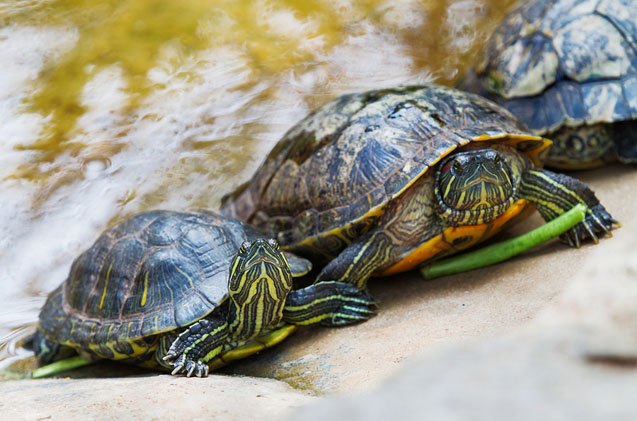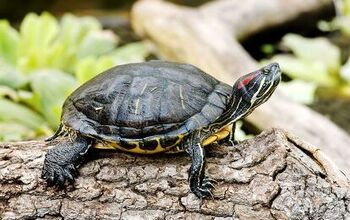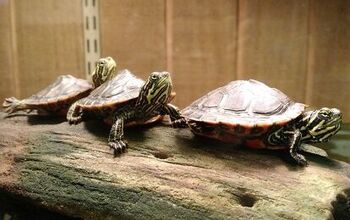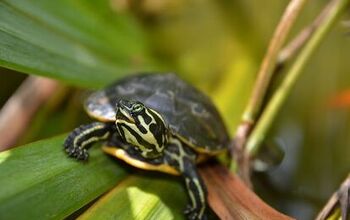Red-Eared Slider Turtle


About Red-Eared Slider Turtle
The Red-Eared Slider Turtle is one of the most popular and most commonly kept pet turtles. These turtles are great swimmers, and they really enjoy spending most of their time underwater; however, they do spend a lot of time basking as well. In fact, on sunny and warm days in the wild, you may find more than one Red-Eared Slider sitting on top of one another while they bask in the sunshine together.
Even though Red-Eared Sliders that are kept as pets will be quite personable and are known for swimming up to their owners and asking for food, these attractive turtles are also easily startled. Even the slightest sound or movement will cause a turtle to quickly slide off of his log or rock and dive right back into the water. This sliding motion, combined with the red mark on either side of the turtle’s head, is how its name was created.
The Red-Eared Slider Turtle is one of the most popular and most commonly kept pet turtles.
This turtle breed has its origins in the area that is found around the Gulf of Mexico and the Mississippi River. It prefers the warmer climates of the southeastern region of the United States, and native habitats include the southeastern part of Colorado, all the way to Virginia and even down to Florida.
In the wild, these turtles prefer warm, still waters, so they will be found in and around creeks, slow flowing rivers, streams, swamps, lakes, and ponds. These calm waters allow them to easily move into and out of the water, and they can easily climb onto tree trunks and rocks that give them the ideal spot for warming themselves while exposed to the sunshine. This means that they are semi-aquatic turtles.
Nevertheless, even though they are native only to these parts of the Americas, the Red-Eared Sliders can be found in the wild all over the world. This is a direct result of pet releases and other reasons, and it makes this turtle breed one of the most invasive species in the world! As such, it is the most common pet turtle, and the most traded turtle breed in the world. In parts of the world where they are not a native wild species, they can become a threat for native flora and fauna.
The Red-Eared Slider Turtle is green and features bright yellow stripes. There is also a distinct red patch located behind both eyes. However, some of these turtles might actually be missing this red spot, and some might even showcase a small red patch on the top of the head.
When looking at the Red-Eared Slider, you will notice that it has strong claws and webbed feet. Hatchlings will feature a shell that is green, and it will have a pattern consisting of dark green or yellow-green marks. However, as these turtles grow, their carapace might become olive green or yellow. The once yellow-green or dark green pattern can also change into patches on every scute, or into dark lines. Also, parts of the turtle’s shell might be red, yellow, or white, and as the animal continues to age, the patches and lines might disappear slowly until the shell becomes a uniform color of dark olive green or a greenish-brown color. Some males might even turn black or dark gray.
There are two color morphs within the Red-Eared Slider Turtle breed, thanks to breeders. The first is called the pastel. These turtles will be lighter and will feature varying levels of yellow and red. The second is albino, and those turtles will be bright yellow when they are young but their color will fade with age. Either way, these little critters are quite charming in every way, and can become the bright little spark in every household.
Even though Red-Eared Sliders are personable, these attractive turtles are also easily startled.
To properly house your Red-Eared Slider Turtle, you will need a tank with a filtration system, a basking dock, a basking lamp that provides both UVA and UVB rays, and a water heater. While all of this might sound too much, it is quite easily available in every pet store. Of course, these gadgets and accessories are quite important for a proper and healthy life for your pet turtle, so make sure you get them first.
Beware that these turtles are messy eaters, and they do create a lot of waste. Therefore, it is best to use a water filter that’s rated for a minimum of double the gallons of water in the tank. In addition to filtration, however, you will need to do regular water changes as well. One of the biggest mistakes that careless turtle owners make is irregular water change. This results in a messy tank full of that nasty green slush, or pondweed known as Zannichellia. These unhygienic conditions can create health problems for your little pet, so don’t allow them to become a common thing.
Set the temperature of the basking area to 85-90°F, and set the water temperature to 75-85°F. Using a water heater and thermometer, you can maintain these temperatures consistently at all times, as the animal’s metabolism will slow down and threaten its health if the temperature drops too low. Also, too many fluctuations in the temperature could result in respiratory ailments. Either way, proper temperature and good hygiene are crucial for your turtle to thrive in this confined environment.
The Red-Eared Slider Turtle is green and features bright yellow stripes.
The Red-Eared Slider Turtle is an omnivorous animal that likes to eat small fish, aquatic vegetation, and even decaying materials in the wild. Therefore, you can feed your turtle a variety of foods.
A good place to start is a commercial turtle diet that will provide adequate nutrition for growth and overall health. As an extra treat, however, you can also give your turtle some leafy greens, worms, crickets, freeze dried krill or shrimp, and minnows. Whatever dietary approach you opt for, you will discover that a red-eared slider turtle is a hearty pet which isn’t too picky about its food. If you are a first time turtle owner and need some guidelines about a good food choice, you can always find information from your local pet store, or a vet.
Besides the diet and optimal conditions in the tank, there isn’t much else you need to ensure for your turtle’s good health. As pets they are usually hardy and hale when cared for properly. Just keep in mind that the first year or two will be instrumental for their well being. Those red-eared sliders that continue thriving after that initial period can be expected to live up to an amazing 30 years! This is great news for all turtle lovers out there. If you develop a bond with your aquatic little friend, you can expect a quirky and docile pet that will always be around to boost your mood and keep you company.
It is always best to get a pet turtle that was hatched in captivity, as they will be more personable. Wild-caught turtles will be much more frightened and cautious of people.
You can expect that, as your Red-Eared Slider gets to know you, he will swim up to you and even beg you for some food. However, when you handle your turtle, he may decide to withdraw and hide in his shell, or he may even bite you if he feels frightened or threatened. While every turtle is an individual and will have his own personality, it is generally not recommended that you handle these animals frequently. After all, you shouldn’t expect a pet that exhibits the same character traits as, for example – a dog. The nature of a turtle is simply too different – it is a reptile, after all. As a pet, a red-eared slider won’t offer much in terms of play or emotion. Some of its natural tendencies will come off as fun and cute, and some goofy behavior will always be there. But in the end, that’s as far as it goes with a pet turtle. Either way, that does not make them any less of a great pet – they are superb in every other way.
Photo credit: aksenovko/Bigstock; vasya_hbo/Bigstock; xbrchx/Bigstock

Lisa Selvaggio is a freelance writer and editor, and our resident cats-pert, with certifications in pet nutrition and pet first aid. She enjoys producing content that helps people understand animals better so they can give their pets a safe and happy home.
More by Lisa Selvaggio

























